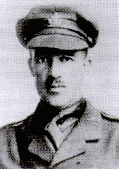

Jack Turner was born in St. John's on November 5, 1887, and was educated at the Methodist College. He was one of five brothers of George and Catherine (Morrison) Turner whose sons all served in World War I. After graduation he worked during 1908 and 1909 on the Anglo-Newfoundland Development Company's timber surveys and then as a railway surveyor for the Reid Newfoundland Company before moving to British Columbia in 1911 where he was employed as a forest surveyor and road engineer.
On November 26, 1914 he enlisted in the Canadian Expeditionary Force in Vancouver. He was twice wounded receiving the Military Cross for his actions at Vimy Ridge. In 1917 he returned to Newfoundland to recover from the effects of "trench fever" and poison gas and helped to train engineers in St. John's for overseas duty. Several of his letters to his father on conditions at the front were published in the St. John's press, while in 1918 he published a collection of war poems entitled Buddy's Blighty and Other Verses From the Trenches, described by a Boston literary critic as a "racy and direct book of singing verses." Captain Turner rejoined the Canadian Army and later served with a contingent assigned to the White Russian Army which fought in Siberia during the Russian Civil War.
Returning to Newfoundland Turner worked until 1927 for the AND company at Grand Falls (where he met and married Blanche Ireland of that town). He supervised forest surveys and inventories covering about 2,000 square miles and conducted rough cruises and reports covering a further 4,000 square miles. He was also responsible for planning, carrying out and supervising AND's logging operations and was assistant to the Woods Manager when he resigned in 1927 to manage W.I. Bishop Limited's timber operations on Newfoundland's west coast. In 1930 he went to Quebec to supervise the construction of a large pulpwood flume for the Anglo-Canadian Pulp and Paper Company.
In 1934 he joined the Newfoundland Department of Natural Resources as chief forester where he implemented a conservation and development program for Crown Lands. During the late 1930s the Forestry Division maintained a logging and sawmilling operations on the Salmonier Line, which trained loggers and served as an experimental model for private logging contractors by showing how working and living conditions for loggers could be improved. In 1938 a tree nursery was established near the sawmill as part of an overall plan to develop seedlings for transplanting on the fire-burnt barrens of the Bonavista and Avalon Peninsulas. This nursery remained in operation until 1952.
When World War II began in 1939 the British Government appointed him officer in charge of the Newfoundland Forestry Unit which eventually included nearly 4,000 loggers. Lieutenant-Colonel Turner returned to Newfoundland in July 1946 resuming his position as chief forester for the government. He died at Ottawa on September 27, 1948 while in the Canadian capital to study the effects of confederation on the work of his department and to press the case of Newfoundland forestry loggers for veterans' status during the negotiations between Canadian and Newfoundland officials concerning the terms of union between the two countries.